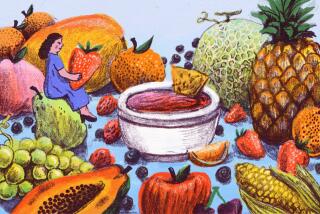fruit punch : The fresh appeal of faux produce and prints for the home stems from a bumper crop of new and realistic interpretations.
- Share via
After years of being snubbed and ignored by home decorators, the banana is chic again--along with apples, pears, lemons, grapes and other fruit.
Many decorators were sour on fruit because they associated it with those cheap plastic bananas and grapes that adorned kitchens in the ‘50s, or avocado-print wallpaper and upholstery of the ‘70s.
Now fruit has returned as the darling of home decors.
While the banana lounge chair’s time may not have arrived, the tutti-frutti look is showing up on wallpaper strewn with grapes or berries, bright tablecloths sprinkled with lemons and cherries, tapestries for upholstery and pillows covered with peaches, plums and pears.
To complement the fruity decor, there’s a bumper crop of fake fruit to adorn tables and countertops. Among the fashionable fruit arrangements: urns filled with cascading grapes, oversized wooden fruit set out on coffee tables, colorful ceramic or papier-ma^che pears and bananas in kitchens and even that proverbial bowlful of cherries.
Thanks to improved technology, much of today’s artificial fruit looks good enough to eat. The pears have bruises; the peaches have fuzz, and the apples have shiny red skin.
“You can’t tell the difference between real and fake fruit. Some things look so real I’m afraid people will eat them,” says Dayna Camarena, floral designer at Susie’s Shoppe in San Clemente, which carries artificial fruit. Apples, pears and other fruit have textured latex coatings or glazed finishes that make them look edible.
“We’re getting apples in that look incredibly real. Every year they get better and better,” Camarena says. “And they won’t spoil.”
Her customers have been making Renaissance-style centerpieces with cascading grapes and berries, wreaths of assorted fruit for their front doors and swags of fruited vines for their walls.
Of course, real fruit can also be used to add a temporary splash of color to a table setting, Camarena says. Some people use bowls of lemons on a dining room table when entertaining instead of the traditional floral arrangement.
Other fruit is unabashedly fake; it’s not intended to fool the eye. Rather, apples, bananas and pears become fodder for art.
“Instead of plastic, there’s fruit made of Venetian glass, marble and porcelain. There’s beautiful ceramic fruit from Europe and Mexico,” says Linda Pratt Notaro, an interior designer in Mission Viejo.
Decorators can pick fruit made of everything from fine china to papier-ma^che, and at a wide range of prices.
“There’s something for everyone--from the high end to quick accessorizing,” Notaro says.
For inexpensive ceramic fruit bowls and platters, she recommends Pier 1 Imports as a source. For more upscale versions, Villeroy & Boch Creation in South Coast Plaza, Costa Mesa, carries fruit-theme porcelain dinnerware. One pattern, called Catalina, comes covered in “fresh berries you could pick off the plate,” says Sarah Hanley, Villeroy & Boch manager.
“People really enjoy fruit. It’s warm and homey,” she says. “It makes people feel comfortable.”
Fruit’s comeback stems from the popularity of floral designs in homes.
“We’ve done flowers to death,” says Abby Menhenett, an interior designer in San Clemente who has seen an increase in fruit on fabrics and wall coverings in interior showrooms. “Flowers are still lovely, but people want something different. And fruit is a real pleasant subject matter.” Indeed, few would take offense to a banana or a strawberry.
“Fruit is cozy and warm, and we all have a love of food,” Notaro says.
The return of classic, traditional interiors has helped foster the fruit trend.
“In the 18th Century, fruits, florals and natural themes were seen in French and Italian painting and tapestry. We’re repeating those themes in all kinds of different colors,” says Lisa Weber, a Fullerton interior designer.
Still, one doesn’t need a traditional interior to decorate with fruit. A big bowl of fruit carved of lightly bleached wood can adorn an iron and marble coffee table in a contemporary home, Weber says.
“It’s a takeoff on the traditional bowl of fruit. It’s not meant to look real,” she says.
A pillow covered in a fruit tapestry in deep purple, gold and blue tones can be used on a white contemporary sofa.
“You can build a room around a neat tapestry,” Weber says.
The colors of the fruit used today--the rich berry, gold, green tones--look striking with white California interiors.
“A bowl of lemons or beautiful Anjou pears provide great contrast,” Notaro says.
Decorators have also been enticed by the greater variety of fabrics with fruity prints. Fruits of all kinds are popping up on upholstery and drapery fabrics, says Emily Fitzpatrick, manager of Calico Corners fabric shop in Huntington Beach.
“We have fabric that looks like old ‘50s tablecloths, with cherries, plums and strawberries in true primary colors, and we have fruit tapestries with grapes, vines and peaches in deeper hues,” Fitzpatrick says. “People are using the tapestries on chairs and sofas.”
Notaro recently decorated a kitchen for a home tour using fruit fabrics and accessories. She used a fruit-print fabric in rich greens, blues and golds to create accent pillows for the back of captain chairs, a table runner, napkins and place mats. Ceramic fruits intermingled with fresh lemons and pears adorned the counters and table.
Fruit isn’t limited to the kitchen.
“I have a client who has a large oil painting of fruit in his living room,” Notaro says. “It’s very dramatic.”
Bowls of fruit and fruit-covered furniture can also go in the dining room and living room, but Menhenett warns that the fruit frenzy can be taken too far.
“I don’t think it belongs in the bath,” she says.
More to Read
Eat your way across L.A.
Get our weekly Tasting Notes newsletter for reviews, news and more.
You may occasionally receive promotional content from the Los Angeles Times.










